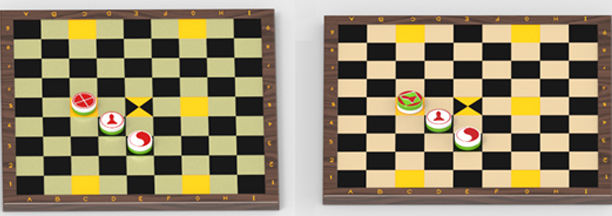Author: Kiều Văn Quảng – Hanoi, Vietnam.
To all chess enthusiasts!
As a child of Hanoi, I have always nurtured a deep passion for intellectual games, where every move is a mental challenge, and every game of chess tells a story. Today, I am excited to introduce to you a masterpiece of thinking and strategy – Yin Yang Chess!
Unlike the familiar pieces on the traditional Chess or Xiangqi boards, Yin Yang Chess brings a completely fresh breath of life, a profound Eastern philosophy embodied in the unique two-sided pieces – the Front and the Reverse sides. This is not merely a battle between two factions, but a dynamic interplay of transformation and mutual support, just like the endless cycle of Yin and Yang in the universe.
The 9×9 chessboard serves as the battleground, with special zones such as the Imperial City – where the King and Advisor initially reside, and the Center of Harmony with the meaningful Tai Chi point at the center. Each side possesses 18 diverse pieces, from the King, Advisor, Elephant, Horse, Chariot, and Pawn, to the unique pieces that define the soul of Yin Yang Chess: the Nghi and Trung pieces.
The Nghi piece – a symbol of transformation – is the most unique feature! This piece does not directly capture the opponent’s pieces but can flip them, turning enemy pieces into your own with a single strategic move, aided by a bait piece from your side. What may seem like a loss of a piece can, in an instant, reverse the balance of power in a dramatic fashion! The Nghi piece can also transform a Trung into a Pawn, or even “check” the opponent’s King in its own unique way.
Then, there’s the Trung piece – a mysterious neutral piece at the start of the game. The Trung does not belong to either side but can be transformed into a powerful Pawn through the influence of the Nghi. The existence or disappearance of the Trung also affects the movement rules of the King and Advisor, creating dramatic moments where the King and Advisor can march directly into the opponent’s Imperial City under certain conditions.
Yin Yang Chess is not just about checkmating the King. The game introduces the concept of “Absolute Victory,” a challenging goal that requires the player to meet a complex set of conditions related to the control of the Nghi, the Trung, and positioning the King at the Tai Chi point. This opens up a world of diverse strategic objectives and creates thrilling, high-stakes games.
With a larger board, a rich array of pieces, and unique movement and interaction mechanics, Yin Yang Chess offers a depth of strategy that rivals Chess itself, while also introducing new variants and situations you’ve never encountered before.
So, set aside your familiar moves for a moment, and embrace Yin Yang Chess to explore an entirely new world of chess – a place where intelligence and creativity are constantly tested, and where each piece holds the potential to turn the tide of the game.
Yin Yang Chess – more than just a game, it is a journey to explore balance, transformation, and the pinnacle of strategic thinking. Join us in this adventure and feel the excitement!

 Tiếng Việt
Tiếng Việt























